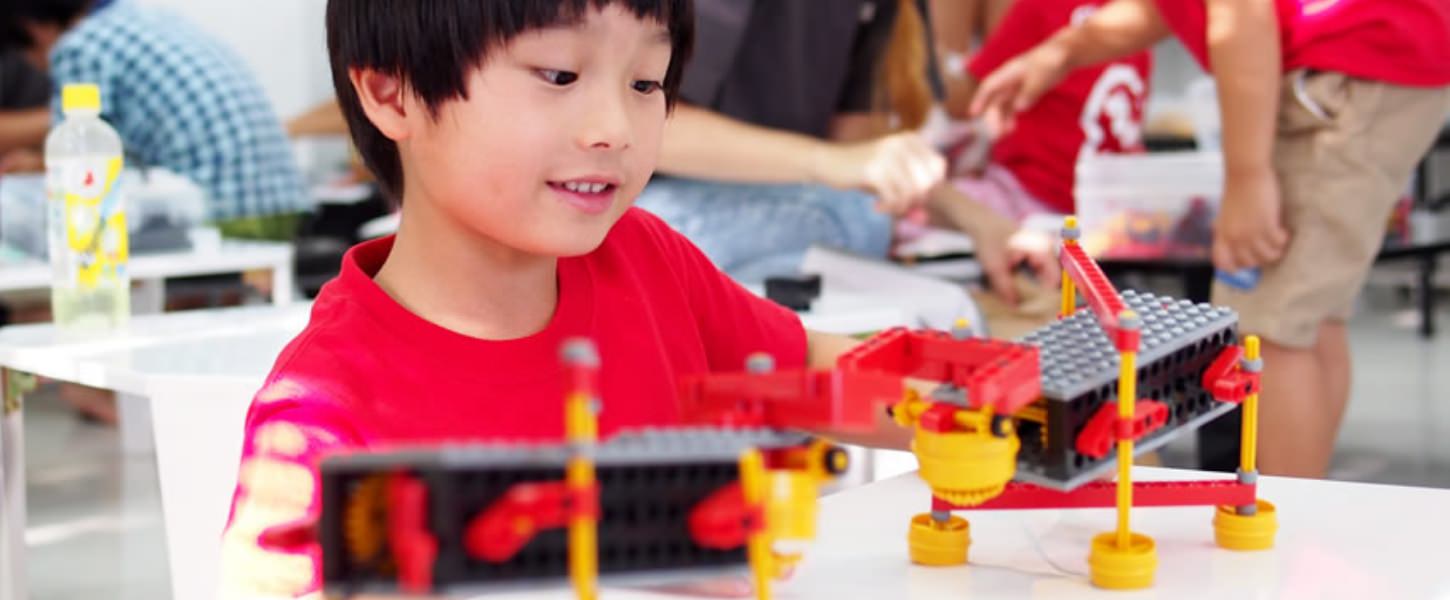ロボットクラス
学びに驚きと感動を!

自ら考え、自ら学ぶ子どもたちを育てる教育をご提供。手を動かし、頭を働かせてイメージしたものをカタチにする。オリジナル教材のロボットを作ることで、子どもの個性を引き出し、想像力/創造力を育みます。また、レッスンは全て英語で行われます。(教材は日本語/英語が選べます。)
コース案内
プレ-プライマリーコース(4~5才/1年間)

小さな手で一歩一歩、無理なくロボットを製作する冒険へと子供たちを導きます。原寸大のパーツ写真と1ページ1ステップのテキストが学びをサポート。ネイティブの講師とともに、ロボット作りと英会話の基礎を同時に学びます。自ら作ったロボットの動きに、驚きと感動を実感できることでしょう。


プライマリーコース(小学校低学年/1年間)

教科書の情報を頼りに、自らの手で動くロボットを製作します。必要に応じて原寸大のパーツ写真を掲載し、直感的な製作手順をわかりやすく示しています。この過程を通じて、設計図から情報を読む力や数を数える能力を自然と身につけることを目指します。
ベーシックコース(小学生/2年間)

ロボットを正確に製作し、その構造や動きの仕組みを観察します。また、観察を通じて、択式や穴埋め式の設問に取り組みながら理解を深めていきます。教科書は、改造のヒントや手順を例示し、自分で考えながら進められる構成になっており、構造や仕組みを理解したうえで、試行錯誤を重ねながら自分だけのロボットに改造することを目指します。


ミドルコース(小学生/2年間)

少ない写真をもとに、より複雑な構造のロボットを製作します。タブレットを用いて、初歩的なビジュアルプログラミング作成にも取り組み、ベーシックコースまでのロボットにはなかった、「感じて、考えて、動く」自律的なロボットを作り上げます。目的意識を持ってロボットを製作し、基礎的なプログラミングを理解した上でロボットを制御できるようになることを目指します。
アドバンスコース(小学校中学年以上/2年間)

本格ロボットの3要素である入力系(センサー)・制御系(マイコンブロック)・出力系(モーター等)を組み合わせることで、より高度な「感じて、考えて、動く」自律的な賢いロボットを作り上げていきます。これまで使用してきた写真入りの製作手順書がなくなり、展開図のみを頼りに創造力/想像力と空間認識能力を働かせてロボット製作に取り組みます。また、出来上がったロボットが思い通りの動きをするように、自ら考えながらロボットやプログラムの開発を行うことを目標とします。

1ヶ月の流れ
ロボット教室のプログラムは基本的に1ヶ月に2回(1回90分)の授業で1体のロボットを製作します。子どもにとっても他の習い事と並行して無理なく行うことができます。1回目の授業では、テキストを見ながら組み立てる基本製作です。失敗や成功を繰り返し、試行錯誤しながら製作する中で、完成したときの感動や動いたときの驚きを体験し、理科・算数への興味を引き出していきます。2回目の授業では、基本製作で作ったロボットをもっと速く走らせるには?もっと力を強くするには?などの課題に応じオリジナル仕様にしていく応用・実戦編です。クラスの友達と楽しくゲームや競技をしながら、動力の仕組み、てこや摩擦など理科の知識を学習します。
クラス概要
| 対象年齢 | 6~12才 |
|---|---|
| 曜日 | 金曜日(名護クラス)、土曜日(海邦クラス) ※時間割りは年齢により異なりますのでお問い合わせ下さい |
| レッスン時間 | 90分間(月2回) |
| 入会金 | 10,000円(初回のみ) |
| 教具代 | 28,500円(初回のみ) |
| 月謝 | 10,500円/1ヶ月 |
- きょうだい割引あり。
- お休みされた場合の振替レッスンあり。
- 上記価格には別途消費税が加算されます。
- 月々のレッスン料はご指定の口座より引落しとなります。
場所
海邦教室
沖縄市海邦2-14-2(マンタ公園すぐ横です)
名護教室
沖縄県名護市港2-1-1(名護中央公民館内)